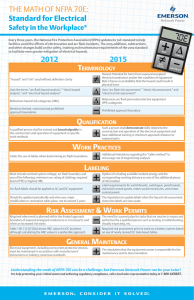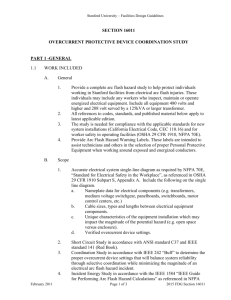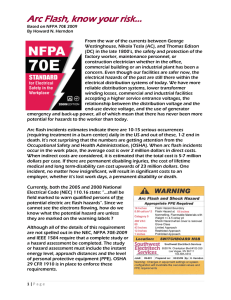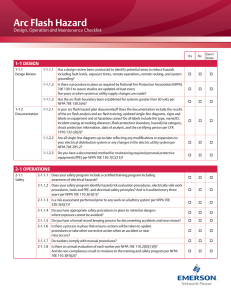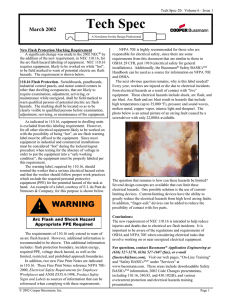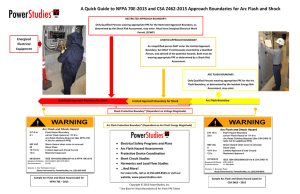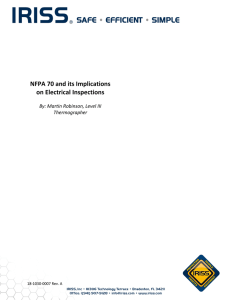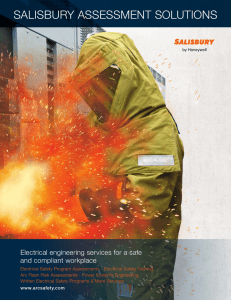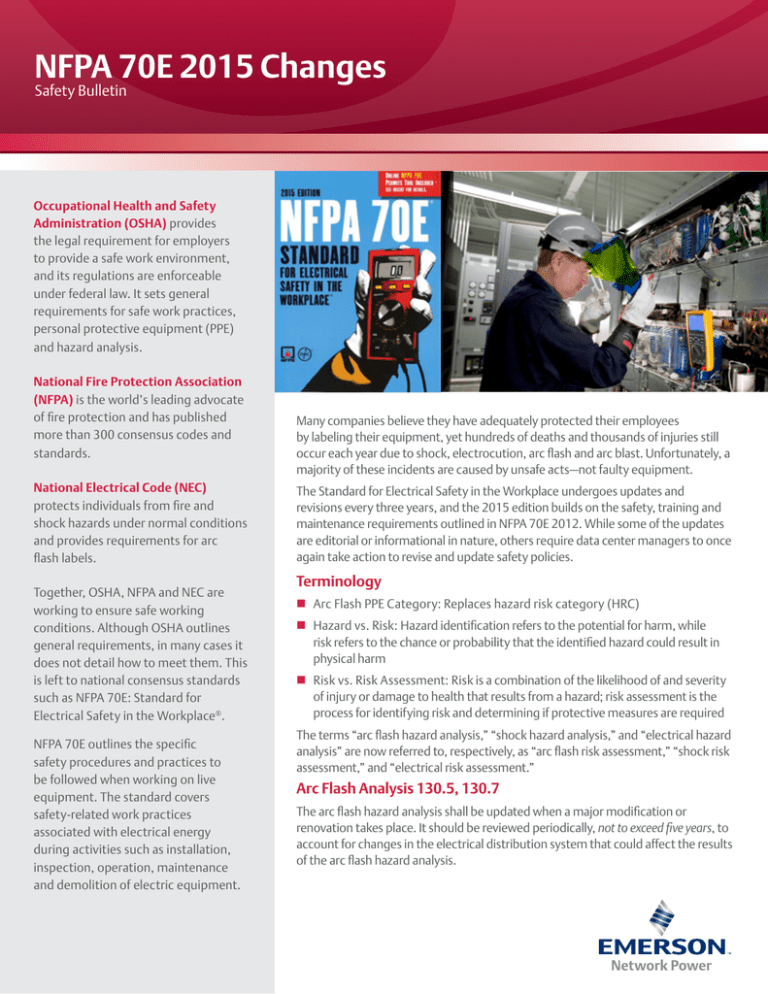
NFPA 70E 2015 Changes
Safety Bulletin
Occupational Health and Safety
Administration (OSHA) provides
the legal requirement for employers
to provide a safe work environment,
and its regulations are enforceable
under federal law. It sets general
requirements for safe work practices,
personal protective equipment (PPE)
and hazard analysis.
National Fire Protection Association
(NFPA) is the world’s leading advocate
of fire protection and has published
more than 300 consensus codes and
standards.
National Electrical Code (NEC)
protects individuals from fire and
shock hazards under normal conditions
and provides requirements for arc
flash labels.
Together, OSHA, NFPA and NEC are
working to ensure safe working
conditions. Although OSHA outlines
general requirements, in many cases it
does not detail how to meet them. This
is left to national consensus standards
such as NFPA 70E: Standard for
Electrical Safety in the Workplace®.
NFPA 70E outlines the specific
safety procedures and practices to
be followed when working on live
equipment. The standard covers
safety-related work practices
associated with electrical energy
during activities such as installation,
inspection, operation, maintenance
and demolition of electric equipment.
Many companies believe they have adequately protected their employees
by labeling their equipment, yet hundreds of deaths and thousands of injuries still
occur each year due to shock, electrocution, arc flash and arc blast. Unfortunately, a
majority of these incidents are caused by unsafe acts—not faulty equipment.
The Standard for Electrical Safety in the Workplace undergoes updates and
revisions every three years, and the 2015 edition builds on the safety, training and
maintenance requirements outlined in NFPA 70E 2012. While some of the updates
are editorial or informational in nature, others require data center managers to once
again take action to revise and update safety policies.
Terminology
Arc Flash PPE Category: Replaces hazard risk category (HRC)
Hazard vs. Risk: Hazard identification refers to the potential for harm, while
risk refers to the chance or probability that the identified hazard could result in
physical harm
Risk vs. Risk Assessment: Risk is a combination of the likelihood of and severity
of injury or damage to health that results from a hazard; risk assessment is the
process for identifying risk and determining if protective measures are required
The terms “arc flash hazard analysis,” “shock hazard analysis,” and “electrical hazard
analysis” are now referred to, respectively, as “arc flash risk assessment,” “shock risk
assessment,” and “electrical risk assessment.”
Arc Flash Analysis 130.5, 130.7
The arc flash hazard analysis shall be updated when a major modification or
renovation takes place. It should be reviewed periodically, not to exceed five years, to
account for changes in the electrical distribution system that could affect the results
of the arc flash hazard analysis.
NFPA 70E 2015 Changes
Safety Bulletin
130.5(A): Requires the arc flash boundary distance to be
calculated (versus using the table method) for all locations
where voltage is greater than 50 volts
110.2(D)(3) and (E): Employees are to be retrained at
intervals not to exceed three years and the training dates
and content for each employee must be documented
130.5(D): Equipment labels must now include the
information below
110.3(C): Meetings between employers and contractors to
communicate known hazards and installation information
the contractor needs to make assessments must be
documented
1. Nominal system voltage
2. Arc flash boundary
3. At least one of the following:
a. Available incident energy and the corresponding
working distance, or the arc flash PPE category in
Table 130.7(C)(15)(A)(b) or Table 130.7(C)(15)(B) for
the equipment, but not both
b. Minimum arc rating of clothing
c. Site-specific level of PPE
NFPA 70E 130.5 includes an exception that permits labels
applied prior to Sept. 30, 2011, as long as they contain the
available incident energy or required level of PPE. This is
acceptable only until the labels come due for review or if an arc
flash hazard risk assessment shows the labels are inaccurate.
110.4: Only qualified persons according to OSHA 1910
shall perform testing and maintenance within the limited
approach boundary
General Maintenance Requirements
205.2, 205.3, 205.4
205.2: A single-line diagram, where provided for the
electrical system, shall be maintained in a legible condition
and shall be kept current
205.3: Electrical equipment shall be maintained in
accordance with manufacturers’ instructions or industry
consensus standards to reduce the risk of failure and the
subsequent exposure of employees to electrical hazards
Table 130.7(C)(16): Provides arc flash category of
the recommended clothing and PPE when it has been
determined, through the use of the task-based tables for
AC and DC systems, that an arc flash hazard exists
205.4: Overcurrent protective devices shall be maintained
in accordance with the manufacturers’ instructions or
industry consensus standards. Maintenance, tests, and
inspections shall be documented
Safety-Related Work Practices
110.1, 110.2, 110.3, 110.4
Industry consensus standards include the following:
110.1(I)(1): Requires that the employer’s electrical safety
program be audited to verify the principles and procedures
of the electrical safety program are in compliance with
this standard; and the audit shall not exceed three years
110.1(I)(2): Field work shall be audited to verify the
requirements contained in the procedures of the electrical
safety program are being followed
110.1(I)(3): The audits shall be documented and revisions
made to any elements not in compliance
110.2(D)(1)(f): Employers are to perform annual
inspections to ensure each employee complies with all
safety-related work practices outlined in 70E
Emerson Network Power
Liebert Services
1-800-LIEBERT
EmersonNetworkPower.com
–– ANSI/NETA 2015 Standard for Maintenance Testing
Specifications and NFPA 70B Recommended Practice for
Electrical Equipment Maintenance
–– Preferred method of performance testing is via primary
current injection
Battery Risk Assessment Requirements 320.3
320.3(A)(1): A risk assessment shall be performed prior
to any work an a battery system to identify the chemical,
electrical shock, and arc flash hazards and assess the risks
associated with the type of tasks to be performed
Emerson, Emerson Network Power and the Emerson Network
Power logo are trademarks and service marks of Emerson
Electric Co. ©2015 Emerson Electric Co. All rights reserved.
CS-00196 (R4/15)


